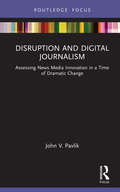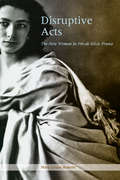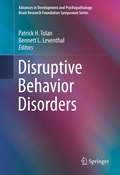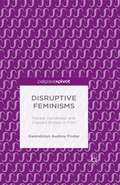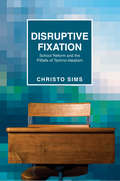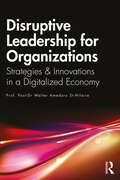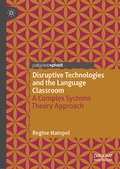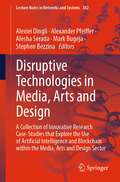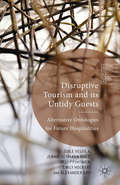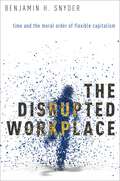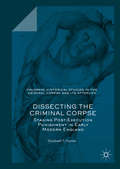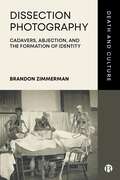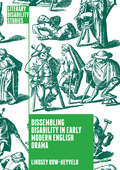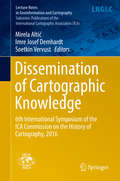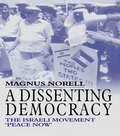- Table View
- List View
Disruption and Digital Journalism: Assessing News Media Innovation in a Time of Dramatic Change (Disruptions)
by John V. PavlikThis book offers a timely insight into how the news media have adapted to the digital transformation of public communication infrastructure. Providing a conceptual roadmap to understanding the disruptive, innovative impact of digital networked journalism in the 21st century, the author critically examines how and to what extent news media around the world have engaged in digital adaptation. Making use of data from news media content production and distribution both off- and online, as well as user and financial data from the U.S. and internationally, the book traces how the news media embraced and reacted to key developments such as the invention of the World Wide Web in 1989 and the launch of Google in 1998, Facebook in 2004, and the Apple iPhone in 2009. The author also highlights innovative organizations that have sought to reimagine news media that are optimized for digital, online, and mobile media of the 21st century, demonstrating how these groups have been able to stay better engaged with the public. Disruption and Digital Journalism is recommended reading for all academics and scholars with an interest in media, digital journalism studies, and technological innovation.
Disruptive Acts: The New Woman in Fin-de-Siecle France
by Mary Louise RobertsIn fin-de-siècle France, politics were in an uproar, and gender roles blurred as never before. Into this maelstrom stepped the "new women," a group of primarily urban, middle-class French women who became the objects of intense public scrutiny. Some remained single, some entered nontraditional marriages, and some took up the professions of medicine and law, journalism and teaching. All of them challenged traditional notions of womanhood by living unconventional lives and doing supposedly "masculine" work outside the home. Mary Louise Roberts examines a constellation of famous new women active in journalism and the theater, including Marguerite Durand, founder of the women's newspaper La Fronde; the journalists Séverine and Gyp; and the actress Sarah Bernhardt. Roberts demonstrates how the tolerance for playacting in both these arenas allowed new women to stage acts that profoundly disrupted accepted gender roles. The existence of La Fronde itself was such an act, because it demonstrated that women could write just as well about the same subjects as men—even about the volatile Dreyfus Affair. When female reporters for La Fronde put on disguises to get a scoop or wrote under a pseudonym, and when actresses played men on stage, they demonstrated that gender identities were not fixed or natural, but inherently unstable. Thanks to the adventures of new women like these, conventional domestic femininity was exposed as a choice, not a destiny. Lively, sophisticated, and persuasive, Disruptive Acts will be a major work not just for historians, but also for scholars of cultural studies, gender studies, and the theater.
Disruptive Acts: The New Woman in Fin-de-Siecle France
by Mary Louise RobertsIn fin-de-siècle France, politics were in an uproar, and gender roles blurred as never before. Into this maelstrom stepped the "new women," a group of primarily urban, middle-class French women who became the objects of intense public scrutiny. Some remained single, some entered nontraditional marriages, and some took up the professions of medicine and law, journalism and teaching. All of them challenged traditional notions of womanhood by living unconventional lives and doing supposedly "masculine" work outside the home. Mary Louise Roberts examines a constellation of famous new women active in journalism and the theater, including Marguerite Durand, founder of the women's newspaper La Fronde; the journalists Séverine and Gyp; and the actress Sarah Bernhardt. Roberts demonstrates how the tolerance for playacting in both these arenas allowed new women to stage acts that profoundly disrupted accepted gender roles. The existence of La Fronde itself was such an act, because it demonstrated that women could write just as well about the same subjects as men—even about the volatile Dreyfus Affair. When female reporters for La Fronde put on disguises to get a scoop or wrote under a pseudonym, and when actresses played men on stage, they demonstrated that gender identities were not fixed or natural, but inherently unstable. Thanks to the adventures of new women like these, conventional domestic femininity was exposed as a choice, not a destiny. Lively, sophisticated, and persuasive, Disruptive Acts will be a major work not just for historians, but also for scholars of cultural studies, gender studies, and the theater.
Disruptive Acts: The New Woman in Fin-de-Siecle France
by Mary Louise RobertsIn fin-de-siècle France, politics were in an uproar, and gender roles blurred as never before. Into this maelstrom stepped the "new women," a group of primarily urban, middle-class French women who became the objects of intense public scrutiny. Some remained single, some entered nontraditional marriages, and some took up the professions of medicine and law, journalism and teaching. All of them challenged traditional notions of womanhood by living unconventional lives and doing supposedly "masculine" work outside the home. Mary Louise Roberts examines a constellation of famous new women active in journalism and the theater, including Marguerite Durand, founder of the women's newspaper La Fronde; the journalists Séverine and Gyp; and the actress Sarah Bernhardt. Roberts demonstrates how the tolerance for playacting in both these arenas allowed new women to stage acts that profoundly disrupted accepted gender roles. The existence of La Fronde itself was such an act, because it demonstrated that women could write just as well about the same subjects as men—even about the volatile Dreyfus Affair. When female reporters for La Fronde put on disguises to get a scoop or wrote under a pseudonym, and when actresses played men on stage, they demonstrated that gender identities were not fixed or natural, but inherently unstable. Thanks to the adventures of new women like these, conventional domestic femininity was exposed as a choice, not a destiny. Lively, sophisticated, and persuasive, Disruptive Acts will be a major work not just for historians, but also for scholars of cultural studies, gender studies, and the theater.
Disruptive Acts: The New Woman in Fin-de-Siecle France
by Mary Louise RobertsIn fin-de-siècle France, politics were in an uproar, and gender roles blurred as never before. Into this maelstrom stepped the "new women," a group of primarily urban, middle-class French women who became the objects of intense public scrutiny. Some remained single, some entered nontraditional marriages, and some took up the professions of medicine and law, journalism and teaching. All of them challenged traditional notions of womanhood by living unconventional lives and doing supposedly "masculine" work outside the home. Mary Louise Roberts examines a constellation of famous new women active in journalism and the theater, including Marguerite Durand, founder of the women's newspaper La Fronde; the journalists Séverine and Gyp; and the actress Sarah Bernhardt. Roberts demonstrates how the tolerance for playacting in both these arenas allowed new women to stage acts that profoundly disrupted accepted gender roles. The existence of La Fronde itself was such an act, because it demonstrated that women could write just as well about the same subjects as men—even about the volatile Dreyfus Affair. When female reporters for La Fronde put on disguises to get a scoop or wrote under a pseudonym, and when actresses played men on stage, they demonstrated that gender identities were not fixed or natural, but inherently unstable. Thanks to the adventures of new women like these, conventional domestic femininity was exposed as a choice, not a destiny. Lively, sophisticated, and persuasive, Disruptive Acts will be a major work not just for historians, but also for scholars of cultural studies, gender studies, and the theater.
Disruptive Acts: The New Woman in Fin-de-Siecle France
by Mary Louise RobertsIn fin-de-siècle France, politics were in an uproar, and gender roles blurred as never before. Into this maelstrom stepped the "new women," a group of primarily urban, middle-class French women who became the objects of intense public scrutiny. Some remained single, some entered nontraditional marriages, and some took up the professions of medicine and law, journalism and teaching. All of them challenged traditional notions of womanhood by living unconventional lives and doing supposedly "masculine" work outside the home. Mary Louise Roberts examines a constellation of famous new women active in journalism and the theater, including Marguerite Durand, founder of the women's newspaper La Fronde; the journalists Séverine and Gyp; and the actress Sarah Bernhardt. Roberts demonstrates how the tolerance for playacting in both these arenas allowed new women to stage acts that profoundly disrupted accepted gender roles. The existence of La Fronde itself was such an act, because it demonstrated that women could write just as well about the same subjects as men—even about the volatile Dreyfus Affair. When female reporters for La Fronde put on disguises to get a scoop or wrote under a pseudonym, and when actresses played men on stage, they demonstrated that gender identities were not fixed or natural, but inherently unstable. Thanks to the adventures of new women like these, conventional domestic femininity was exposed as a choice, not a destiny. Lively, sophisticated, and persuasive, Disruptive Acts will be a major work not just for historians, but also for scholars of cultural studies, gender studies, and the theater.
Disruptive Acts: The New Woman in Fin-de-Siecle France
by Mary Louise RobertsIn fin-de-siècle France, politics were in an uproar, and gender roles blurred as never before. Into this maelstrom stepped the "new women," a group of primarily urban, middle-class French women who became the objects of intense public scrutiny. Some remained single, some entered nontraditional marriages, and some took up the professions of medicine and law, journalism and teaching. All of them challenged traditional notions of womanhood by living unconventional lives and doing supposedly "masculine" work outside the home. Mary Louise Roberts examines a constellation of famous new women active in journalism and the theater, including Marguerite Durand, founder of the women's newspaper La Fronde; the journalists Séverine and Gyp; and the actress Sarah Bernhardt. Roberts demonstrates how the tolerance for playacting in both these arenas allowed new women to stage acts that profoundly disrupted accepted gender roles. The existence of La Fronde itself was such an act, because it demonstrated that women could write just as well about the same subjects as men—even about the volatile Dreyfus Affair. When female reporters for La Fronde put on disguises to get a scoop or wrote under a pseudonym, and when actresses played men on stage, they demonstrated that gender identities were not fixed or natural, but inherently unstable. Thanks to the adventures of new women like these, conventional domestic femininity was exposed as a choice, not a destiny. Lively, sophisticated, and persuasive, Disruptive Acts will be a major work not just for historians, but also for scholars of cultural studies, gender studies, and the theater.
Disruptive Behavior Disorders (Advances in Development and Psychopathology: Brain Research Foundation Symposium Series #1)
by Patrick H. Tolan and Bennett L. LeventhalAggressive behavior among children and adolescents has confounded parents and perplexed professionals—especially those tasked with its treatment and prevention—for countless years. As baffling as these behaviors are, however, recent advances in neuroscience focusing on brain development have helped to make increasing sense of their complexity.Focusing on their most prevalent forms, Oppositional Defiant Disorder and Conduct Disorder, Disruptive Behavior Disorders advances the understanding of DBD on a number of significant fronts. Its neurodevelopmental emphasis within an ecological approach offers links between brain structure and function and critical environmental influences and the development of these specific disorders. The book's findings and theories help to differentiate DBD within the contexts of normal development, non-pathological misbehavior and non-DBD forms of pathology. Throughout these chapters are myriad implications for accurate identification, effective intervention and future cross-disciplinary study.Key issues covered include:Gene-environment interaction models.Neurobiological processes and brain functions.Callous-unemotional traits and developmental pathways.Relationships between gender and DBD.Multiple pathways of familial transmission.Disruptive Behavior Disorders is a groundbreaking resource for researchers, scientist-practitioners and graduate students in clinical child and school psychology, psychiatry, educational psychology, prevention science, child mental health care, developmental psychology and social work.
Disruptive Feminisms: Raced, Gendered, and Classed Bodies in Film
by Gwendolyn Audrey FosterDisruptive Feminisms provides a revolutionary new approach to feminism as a disruptive force. By examining various films and filmmakers who are not so obviously read as feminist or Marxist, Gwendolyn Foster showcases their ability to disrupt and effectively challenge everything from class and racism, as well as sexism, ageism, and homophobia.
Disruptive Fixation: School Reform and the Pitfalls of Techno-Idealism
by Christo SimsIn New York City in 2009, a new kind of public school opened its doors to its inaugural class of middle schoolers. Conceived by a team of game designers and progressive educational reformers and backed by prominent philanthropic foundations, it promised to reinvent the classroom for the digital age. Ethnographer Christo Sims documented the life of the school from its planning stages to the graduation of its first eighth-grade class. Disruptive Fixation is his account of how this "school for digital kids," heralded as a model of tech-driven educational reform, reverted to a more conventional type of schooling with rote learning, an emphasis on discipline, and traditional hierarchies of authority. Troubling gender and racialized class divisions also emerged.Sims shows how the philanthropic possibilities of new media technologies are repeatedly idealized even though actual interventions routinely fall short of the desired outcomes—often dramatically so. He traces the complex processes by which idealistic tech-reform perennially takes root, unsettles the worlds into which it intervenes, and eventually stabilizes in ways that remake and extend many of the social predicaments reformers hope to fix. Sims offers a nuanced look at the roles that powerful elites, experts, the media, and the intended beneficiaries of reform—in this case, the students and their parents—play in perpetuating the cycle.Disruptive Fixation offers a timely examination of techno-philanthropism and the yearnings and dilemmas it seeks to address, revealing what failed interventions do manage to accomplish—and for whom.
Disruptive Fixation: School Reform and the Pitfalls of Techno-Idealism (PDF)
by Christo SimsIn New York City in 2009, a new kind of public school opened its doors to its inaugural class of middle schoolers. Conceived by a team of game designers and progressive educational reformers and backed by prominent philanthropic foundations, it promised to reinvent the classroom for the digital age. Ethnographer Christo Sims documented the life of the school from its planning stages to the graduation of its first eighth-grade class. Disruptive Fixation is his account of how this "school for digital kids," heralded as a model of tech-driven educational reform, reverted to a more conventional type of schooling with rote learning, an emphasis on discipline, and traditional hierarchies of authority. Troubling gender and racialized class divisions also emerged.Sims shows how the philanthropic possibilities of new media technologies are repeatedly idealized even though actual interventions routinely fall short of the desired outcomes—often dramatically so. He traces the complex processes by which idealistic tech-reform perennially takes root, unsettles the worlds into which it intervenes, and eventually stabilizes in ways that remake and extend many of the social predicaments reformers hope to fix. Sims offers a nuanced look at the roles that powerful elites, experts, the media, and the intended beneficiaries of reform—in this case, the students and their parents—play in perpetuating the cycle.Disruptive Fixation offers a timely examination of techno-philanthropism and the yearnings and dilemmas it seeks to address, revealing what failed interventions do manage to accomplish—and for whom.
Disruptive Leadership for Organizations: Strategies & Innovations in a Digitalized Economy
by Walter Amedzro St-HilaireAimed as much at the neophyte as at the insider who questions why intellectual property rights (IPRs) matter in the digital age and the corporate strategies in the digitalised economy, this book approaches with perspicacity the development of disruptive mechanisms for organisations and IPR-centric leadership. The book is focused on organisations and a management systems perspective. The book identifies the technical practices and proposes multi-level strategies to promote disruptive leadership and encourage growth. The book then addresses the fundamentals of innovation and technology governance, from the production of ideas to the distribution of innovative products or services, including prototyping, financing, industrialisation and so on. It presents recent challenges, including open innovation, creativity and design thinking, and innovation of business models, placing them in the context of knowledge and the collaborative economy. The ambition of the book is to propose a framework for thought and action to the manager, which is composed of five walls – organisational creativity, intellectual property, financing, manufacturing and design of innovation – brought together under one roof, the business model of the technology. This device in which the manager must fit is situated in the strategy of his company and is to be embedded in a specific macroeconomic space.
Disruptive Leadership for Organizations: Strategies & Innovations in a Digitalized Economy
by Walter Amedzro St-HilaireAimed as much at the neophyte as at the insider who questions why intellectual property rights (IPRs) matter in the digital age and the corporate strategies in the digitalised economy, this book approaches with perspicacity the development of disruptive mechanisms for organisations and IPR-centric leadership. The book is focused on organisations and a management systems perspective. The book identifies the technical practices and proposes multi-level strategies to promote disruptive leadership and encourage growth. The book then addresses the fundamentals of innovation and technology governance, from the production of ideas to the distribution of innovative products or services, including prototyping, financing, industrialisation and so on. It presents recent challenges, including open innovation, creativity and design thinking, and innovation of business models, placing them in the context of knowledge and the collaborative economy. The ambition of the book is to propose a framework for thought and action to the manager, which is composed of five walls – organisational creativity, intellectual property, financing, manufacturing and design of innovation – brought together under one roof, the business model of the technology. This device in which the manager must fit is situated in the strategy of his company and is to be embedded in a specific macroeconomic space.
Disruptive Technologies and the Language Classroom: A Complex Systems Theory Approach
by Regine HampelAlthough new technologies are embedded in students’ lives today, there is often an assumption that their use is transparent, inconsequential, or a distraction. This book combines complex systems theory with sociocultural theory and the multimodal theory of communication, providing an innovative theoretical framework to examine how communication and meaning-making in the language classroom have developed over time, how technology impacts on meaning-making, and what the implications are for learners, teachers, institutions and policy makers. Recent studies provide evidence for the disruptive effect of technology which has resulted in a phase shift that is reshaping language education by creating new interaction patterns, allowing for multimodal communication, and introducing real-world communication into the classroom. The book proposes ways of responding to this shift before concluding that the new technologies are radically transforming the way we learn. It is likely to appeal to a range of readers, including students, academics, teachers and policy-makers.
Disruptive Technologies in Media, Arts and Design: A Collection of Innovative Research Case-Studies that Explore the Use of Artificial Intelligence and Blockchain within the Media, Arts and Design Sector (Lecture Notes in Networks and Systems #382)
by Alexiei Dingli Alexander Pfeiffer Alesha Serada Mark Bugeja Stephen BezzinaThis book presents selected proceedings from two installments of the MAD Conference in 2020—MAD Blockchain 2020 and MAD Artificial Intelligence 2020. These events focused on applications of these novel technologies in media, arts and design. A number of researchers present their own projects and practical implementations of blockchain and AI in games, art, education and sustainable living, while other authors explore theoretical and ethical questions that these technologies bring into society. First and foremost, we recommend this book to aspiring scholars and practitioners who are also building new solutions using blockchain and AI. Besides, the book extends the existing scholarship on AI and blockchain and provides proven cases and tools for education in ICT. The conference has been organized by Danube-University Krems, Drexel University Philadelphia and University of Malta with support from the MIT Education Arcade, the Texas A&M LIVE Lab and University of Vaasa.
Disruptive Tourism and its Untidy Guests: Alternative Ontologies for Future Hospitalities (Leisure Studies in a Global Era)
by Olli Pyyhtinen Emily Höckert S. Veijola J. Germann Molz E. Hockert Alexander Grit Jennie Germann MolzThis book invokes the radical potentialities of 'untidiness' to envision alternative arrangements of social life and hospitality. Instead of trying to manage sustainability or tidy up tourist situations, the authors embrace the messiness of human relations and argue for more creative, embodied and ethical ontologies of tourism and mobility.
DISRUPTIVE WORKPLACE C: Time and the Moral Order of Flexible Capitalism
by Benjamin H. SnyderThe twenty-first century workplace compels Americans to be more flexible, often at a cost to their personal well-being. In The Disrupted Workplace, Benjamin Snyder examines how three groups of American workers construct moral order in a capitalist system that demands flexibility. Snyder argues that new scheduling techniques, employment strategies, and technologies disrupt the flow and trajectory of working life, transforming how workers experience time. Work can feel both liberating and terrorizing, engrossing in the short term but unsustainable in the long term. Through a vivid portrait of workers' struggles to adapt their lives to constant disruption, The Disrupted Workplace mounts a compelling critique of the price of the flexible economy.
Dissecting the Criminal Corpse: Staging Post-Execution Punishment in Early Modern England (Palgrave Historical Studies in the Criminal Corpse and its Afterlife)
by Elizabeth T. HurrenThose convicted of homicide were hanged on the public gallows before being dissected under the Murder Act in Georgian England. Yet, from 1752, whether criminals actually died on the hanging tree or in the dissection room remained a medical mystery in early modern society. Dissecting the Criminal Corpse takes issue with the historical cliché of corpses dangling from the hangman’s rope in crime studies. Some convicted murderers did survive execution in early modern England. Establishing medical death in the heart-lungs-brain was a physical enigma. Criminals had large bull-necks, strong willpowers, and hearty survival instincts. Extreme hypothermia often disguised coma in a prisoner hanged in the winter cold. The youngest and fittest were capable of reviving on the dissection table. Many died under the lancet. Capital legislation disguised a complex medical choreography that surgeons staged. They broke the Hippocratic Oath by executing the Dangerous Dead across England from 1752 until 1832. This book is open access under a CC-BY license.
Dissection Photography: Cadavers, Abjection, and the Formation of Identity
by Brandon ZimmermanContemporary audiences are often shocked to learn that in the late 19th and early 20th centuries, medical students around the world posed for photographic portraits with their cadavers; a genre known as dissection photography. Featuring previously unseen images, stories, and anecdotes, this book explores the visual culture of death within the gross anatomy lab through the tradition of dissection photography, examining its historical aspects from both photographic and medical perspectives. The author pays particular attention to the use of dissection photographs as an expression of student identity, and as an evolving transgressive ritual intricately connected to, and eventually superseding, the act of dissection itself.
Dissection Photography: Cadavers, Abjection, and the Formation of Identity
by Brandon ZimmermanContemporary audiences are often shocked to learn that in the late 19th and early 20th centuries, medical students around the world posed for photographic portraits with their cadavers; a genre known as dissection photography. Featuring previously unseen images, stories, and anecdotes, this book explores the visual culture of death within the gross anatomy lab through the tradition of dissection photography, examining its historical aspects from both photographic and medical perspectives. The author pays particular attention to the use of dissection photographs as an expression of student identity, and as an evolving transgressive ritual intricately connected to, and eventually superseding, the act of dissection itself.
Dissembling Disability in Early Modern English Drama (Literary Disability Studies)
by Lindsey Row-HeyveldWhy do able-bodied characters fake disability in 40 early modern English plays? This book uncovers a previously unexamined theatrical tradition and explores the way counterfeit disability captivated the Renaissance stage. Through detailed case studies of both lesser-known and canonical plays (by Shakespeare, Jonson, Marston, and others), Lindsey Row-Heyveld demonstrates why counterfeit disability proved so useful to early modern playwrights. Changing approaches to almsgiving in the English Reformation led to increasing concerns about feigned disability. The theater capitalized on those concerns, using the counterfeit-disability tradition to explore issues of charity, epistemology, and spectatorship. By illuminating this neglected tradition, this book fills an important gap in both disability history and literary studies, and explores how fears of counterfeit disability created a feedback loop of performance and suspicion. The result is the still-pervasive insistence that even genuinely disabled people must perform in order to, paradoxically, prove the authenticity of their impairments.
Dissemination and Implementation Research in Health: Translating Science to Practice
by Ross C. Brownson, Graham A. Coldi TZ, Enola K. ProctorThe ultimate guide to dissemination and implementation research for public health, medicine, and the social sciences In the past twenty years, dissemination and implementation (D&I) research has sought to narrow the gap between the discovery of new knowledge and its application in public health, mental health, and health care settings. The challenges of moving research to practice and policy are universal, and future progress calls for collaborative partnerships and cross-country research. The fundamental tenet of D&I research-taking what we know about improving health and putting it into practice-must be the highest priority. Dissemination and Implementation Research in Health is the definitive roadmap to effecting change in health and science from today's leading D&I researchers. With insights from around the globe, these scholars collectively address key issues in the field including how to evaluate evidence based on effective interventions, how to design an appropriate study, and how to track a set of essential outcomes. Their work has been updated in this third edition with a strong focus on health equity and new chapters on de-implementation, scale-up and sustainment, and training and capacity building. This new edition also focuses on barriers to uptake of evidence-based interventions in the communities where people live their lives and from the social service agencies, hospitals, and clinics where they receive care. Now in its third edition, Dissemination and Implementation Research in Health remains the quintessential guide to making research more consequential for researchers and practitioners in health and the social sciences.
Dissemination and Implementation Research in Health: Translating Science to Practice
The ultimate guide to dissemination and implementation research for public health, medicine, and the social sciences In the past twenty years, dissemination and implementation (D&I) research has sought to narrow the gap between the discovery of new knowledge and its application in public health, mental health, and health care settings. The challenges of moving research to practice and policy are universal, and future progress calls for collaborative partnerships and cross-country research. The fundamental tenet of D&I research-taking what we know about improving health and putting it into practice-must be the highest priority. Dissemination and Implementation Research in Health is the definitive roadmap to effecting change in health and science from today's leading D&I researchers. With insights from around the globe, these scholars collectively address key issues in the field including how to evaluate evidence based on effective interventions, how to design an appropriate study, and how to track a set of essential outcomes. Their work has been updated in this third edition with a strong focus on health equity and new chapters on de-implementation, scale-up and sustainment, and training and capacity building. This new edition also focuses on barriers to uptake of evidence-based interventions in the communities where people live their lives and from the social service agencies, hospitals, and clinics where they receive care. Now in its third edition, Dissemination and Implementation Research in Health remains the quintessential guide to making research more consequential for researchers and practitioners in health and the social sciences.
Dissemination of Cartographic Knowledge: 6th International Symposium of the ICA Commission on the History of Cartography, 2016 (Lecture Notes in Geoinformation and Cartography)
by Mirela Altić Imre Josef Demhardt Soetkin VervustThis book gathers 22 papers which were presented at the 6th International Symposium of the ICA Commission on the History of Cartography in Dubrovnik, Croatia on 13–15 October 2016. The overall conference theme was ‘The Dissemination of Cartographic Knowledge: Production – Trade – Consumption – Preservation’. The book presents original research by internationally respected authors in the field of historical cartography, offering a significant contribution to the development of this field of study, but also of geography, history and the GIS sciences. The primary target audience includes researchers, educators, postgraduate students, map librarians and archivists.
A Dissenting Democracy: The Israeli Movement 'Peace Now' (Israeli History, Politics and Society #No. 18)
by Magnus NorellA Dissenting Democracy explores the tension between the will of the whole of Israeli society and the right of the individual conscience to take precedence over that collective will. The author explores the dilemmas that stem from such an individual stance in relation to Jewish political culture.
